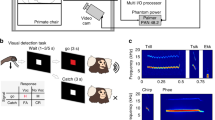Abstract
Motor development has been extensively studied in human infants and children, with several established scales for the evaluation of motor functions. However, the study of the neuronal mechanisms underlying human motor development is hampered by the lack of good animal models. The common marmoset (Callithrix jacchus), a small New World monkey, has recently attracted much attention as a potential nonhuman primate model for understanding human physiology and diseases. However, little is known about its gross motor development. In the present study, we found that marmosets have a critical period for motor development in postnatal weeks 2 to 5, and acquire most of their motor skills by 8 weeks of age. We also developed methods to assess their motor functions, which will be useful for the evaluation of motor performance in marmoset models of human diseases. In addition, we found that marmosets exhibit a “head-to-tail” sequence of motor development similar to that found in humans, further supporting the notion that they provide a good animal model for studying the neuronal mechanisms underlying human motor development.
Similar content being viewed by others
References
Piper MC, Pinnell LE, Darrah J, Maguire T, Byrne PJ. Construction and validation of the Alberta Infant Motor Scale (AIMS). Can J Public Health 1992, 83(Suppl 2): S46–50.
Thelen E. Motor development. A new synthesis. Am Psychol 1995, 50: 79–95.
Heriza C. Motor development: traditional and contemporary theories. Contemporary Management of Motor Control Problems: Proceedings of the II STEP Conference. Alexandria, Va: Foundation for Physical Therapy 1991: 99–126.
Yang SH, Cheng PH, Banta H, Piotrowska-Nitsche K, Yang JJ, Cheng EC, et al. Towards a transgenic model of Huntington’s disease in a non-human primate. Nature 2008, 453: 921–924.
Kordower JH, Emborg ME, Bloch J, Ma SY, Chu Y, Leventhal L, et al. Neurodegeneration prevented by lentiviral vector delivery of GDNF in primate models of Parkinson’s disease. Science 2000, 290: 767–773.
Mansfield K. Marmoset models commonly used in biomedical research. Comp Med 2003, 53: 383–392.
Sasaki E, Suemizu H, Shimada A, Hanazawa K, Oiwa R, Kamioka M, et al. Generation of transgenic non-human primates with germline transmission. Nature 2009, 459: 523–527.
Hook MA, Rogers LJ. Development of hand preferences in marmosets (Callithrix jacchus) and effects of aging. J Comp Psychol 2000, 114: 263–271.
Kaplan G, Rogers LJ. Head-cocking as a form of exploration in the common marmoset and its development. Dev Psychobiol 2006, 48: 551–560.
Verhave PS, Vanwersch RA, van Helden HP, Smit AB, Philippens IH. Two new test methods to quantify motor deficits in a marmoset model for Parkinson’s disease. Behav Brain Res 2009, 200: 214–219.
Iwanami A, Yamane J, Katoh H, Nakamura M, Momoshima S, Ishii H, et al. Establishment of graded spinal cord injury model in a nonhuman primate: the common marmoset. J Neurosci Res 2005, 80: 172–181.
Marshall JW, Ridley RM. Assessment of cognitive and motor deficits in a marmoset model of stroke. ILAR J 2003, 44: 153–160.
Tardif SD, Mansfield KG, Ratnam R, Ross CN, Ziegler TE. The marmoset as a model of aging and age-related diseases. ILAR J 2011, 52: 54–65.
McGraw MB. The Neuromuscular Maturation of the Human Infant. London: Mac Keith Press, 1943. Reprinted 1989: Classics in Developmental Medicine No.4.
Gesell A. The ontogenesis of infant behavior. In: Carmichael L (Ed.). Manual of Child Psychology. Hoboken, NJ: John Wiley & Sons Inc, 1946.
Bernstein NA. The co-ordination and regulation of movements. Oxford, UK: Pergamon Press Ltd., 1967.
Schoner G, Kelso JA. Dynamic pattern generation in behavioral and neural systems. Science 1988, 239: 1513–1520.
Author information
Authors and Affiliations
Corresponding author
Rights and permissions
About this article
Cite this article
Wang, Y., Fang, Q. & Gong, N. Motor assessment of developing common marmosets. Neurosci. Bull. 30, 387–393 (2014). https://doi.org/10.1007/s12264-013-1395-y
Received:
Accepted:
Published:
Issue Date:
DOI: https://doi.org/10.1007/s12264-013-1395-y




